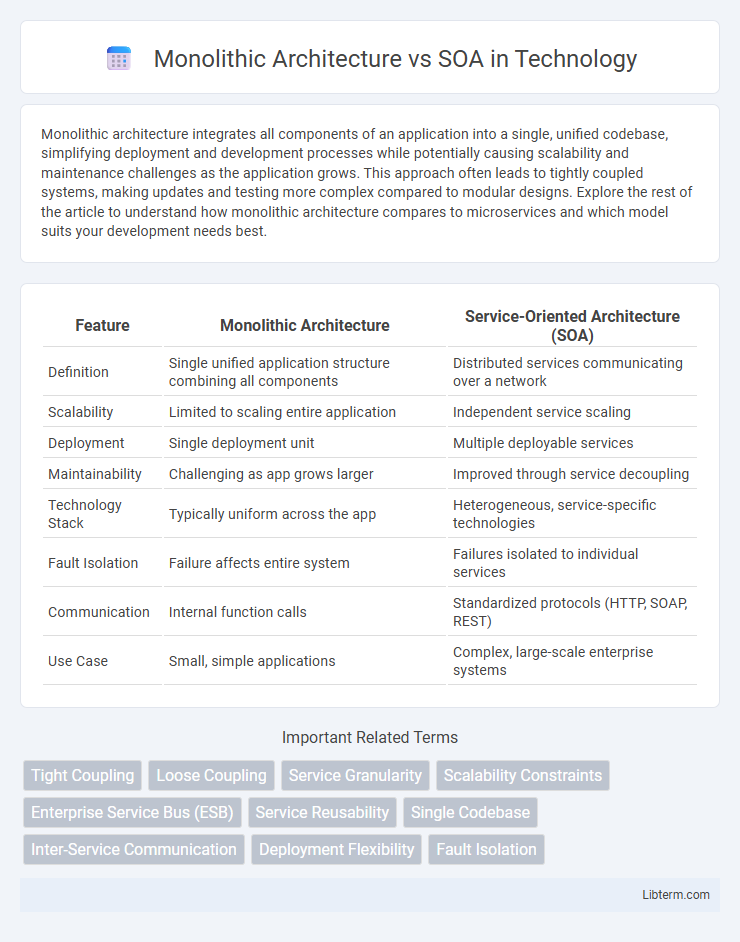Monolithic architecture integrates all components of an application into a single, unified codebase, simplifying deployment and development processes while potentially causing scalability and maintenance challenges as the application grows. This approach often leads to tightly coupled systems, making updates and testing more complex compared to modular designs. Explore the rest of the article to understand how monolithic architecture compares to microservices and which model suits your development needs best.
Table of Comparison
| Feature | Monolithic Architecture | Service-Oriented Architecture (SOA) |
|---|---|---|
| Definition | Single unified application structure combining all components | Distributed services communicating over a network |
| Scalability | Limited to scaling entire application | Independent service scaling |
| Deployment | Single deployment unit | Multiple deployable services |
| Maintainability | Challenging as app grows larger | Improved through service decoupling |
| Technology Stack | Typically uniform across the app | Heterogeneous, service-specific technologies |
| Fault Isolation | Failure affects entire system | Failures isolated to individual services |
| Communication | Internal function calls | Standardized protocols (HTTP, SOAP, REST) |
| Use Case | Small, simple applications | Complex, large-scale enterprise systems |
Introduction to Monolithic Architecture and SOA
Monolithic architecture is a traditional software design model where all components and functionalities are integrated into a single, unified codebase, facilitating simple deployment but limiting scalability and flexibility. Service-Oriented Architecture (SOA) organizes software as a collection of loosely coupled services communicating over a network, enabling modular development, better scalability, and easier maintenance. SOA promotes reusability and integration across diverse systems, contrasting with the tightly coupled nature of monolithic applications.
Core Concepts: Monolithic Architecture
Monolithic architecture centralizes all components of an application into a single, unified codebase, enabling direct function calls and tightly coupled modules. This design simplifies deployment and testing but can lead to scalability challenges and reduced flexibility as the application grows. Core concepts include unified data management, shared resources, and a single executable deployment package.
Core Concepts: Service-Oriented Architecture (SOA)
Service-Oriented Architecture (SOA) organizes software as a collection of loosely coupled services that communicate over a network, enabling flexibility and reuse across different systems. Each service in SOA is designed around specific business functions, promoting interoperability and scalability by allowing independent service development, deployment, and maintenance. SOA contrasts with monolithic architecture by decoupling functionalities into discrete services, improving agility and enabling integration with heterogeneous technologies.
Key Differences Between Monolithic and SOA
Monolithic architecture consolidates all components into a single, unified codebase, leading to tight coupling and limited scalability, whereas SOA (Service-Oriented Architecture) divides functionalities into independent, reusable services enhancing modularity and flexibility. Monolithic systems often face challenges in deployment and maintenance due to their interconnected nature, while SOA enables easier updates and integration through standardized communication protocols like SOAP or REST. Performance considerations differ as monoliths can offer faster internal calls, but SOA provides superior resilience and adaptability in distributed environments.
Advantages of Monolithic Architecture
Monolithic architecture offers simplicity in development and deployment due to its unified codebase, which enhances performance by minimizing inter-service communication overhead. It enables easier debugging and testing since all components reside in a single environment, streamlining maintenance and reducing complexity. Centralized management in monolithic systems also accelerates development cycles and lowers initial infrastructure costs compared to distributed SOA implementations.
Advantages of SOA
Service-Oriented Architecture (SOA) enhances scalability and flexibility by enabling independent deployment and management of services, which contrasts with the tightly coupled structure of monolithic architecture. SOA improves system interoperability and facilitates seamless integration across heterogeneous platforms, promoting better reuse of existing components and reducing development time. Its modular design supports easier maintenance and adaptability to evolving business requirements, driving greater agility and operational efficiency.
Common Challenges in Monolithic Systems
Monolithic architecture often faces challenges such as limited scalability, as all components are tightly coupled and deployed as a single unit, making it difficult to update or scale specific functionalities independently. This tight coupling introduces increased risk of system-wide failures and complicates debugging and maintenance due to intertwined dependencies. Performance bottlenecks and slower deployment cycles further hinder agility in evolving business requirements compared to a Service-Oriented Architecture (SOA) approach.
Common Challenges in SOA Implementations
SOA implementations often face challenges such as service granularity issues, increased complexity in managing distributed services, and difficulties ensuring consistent communication protocols across diverse platforms. Performance bottlenecks arise from network latency and service orchestration overhead, affecting scalability and responsiveness. Security concerns also intensify with multiple service endpoints requiring robust authentication and authorization mechanisms.
Selecting the Right Architecture for Your Business
Selecting the right architecture for your business depends on scalability, flexibility, and maintenance requirements. Monolithic architecture suits smaller applications with tightly coupled components, offering simplicity and ease of deployment. Service-Oriented Architecture (SOA) provides modularity and interoperability, ideal for large enterprises seeking to integrate diverse services and enhance scalability.
Future Trends: Monolithic vs SOA
Monolithic architecture, traditionally favored for its simplicity and tightly integrated components, faces scalability and maintenance challenges as applications grow in complexity, prompting a shift toward Service-Oriented Architecture (SOA) for future-proofing enterprises. SOA's modular approach enables independent service deployment, improved scalability, and enhanced agility, aligning with trends in microservices and cloud-native development. Emerging technologies like containerization and orchestration tools further accelerate SOA adoption by facilitating seamless integration, continuous delivery, and dynamic resource management in evolving IT landscapes.
Monolithic Architecture Infographic

 libterm.com
libterm.com